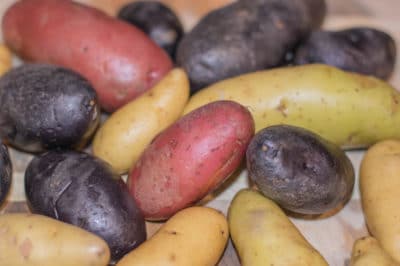Characteristics of Fingerling Potatoes
Like other kinds of potatoes, fingerlings are available in different colors – red, creamy white, yellow and even purple. They may be starchy or waxy and are known for their complex flavors. The thin skins make them prone to damage if bruised. Commonly cooked whole and unpeeled, they are used in side dishes or salads, but can also be fried or mashed.
Fingerling Potato Varieties
Fingerlings, like regular potatoes, vary in size and shape. They include:
- Rose Finn – deep yellow flesh and dark pink skin.
- Peanut – shaped like a teardrop crescent; light brown skin and yellow flesh.
- Ozette – excellent flavor, gold to yellow skin and flesh.
- La Ratte – nutty rich flavor; yellow skin and deep gold flesh.
- Peruvian Purple – purple flesh and skin, very popular.
Planting Fingerlings
Like all potatoes, fingerlngs need very fertile, well-drained soil that is loose and friable. They should be planted in full sun and can be grown in all USDA zones. Cool-season plants, they do best if planted about the time of the last frost – most gardeners sprout or chit them for several weeks prior to planting. They will not grow as well in hot temperatures – desert gardeners usually grow them as a winter crop.
Growing Fingerlings
Plant small whole or cut up pieces of fingerling potatoes two to three inches deep and about one foot apart. Fingerlings must have plenty of water while actively growing, but they are also sensitive to soggy soils. Water frequently enough to keep the soil slightly damp. Hill the plants – cover them with several inches of soil – at least twice while growing.
Disease Prevention
While individual fingerling potatoes may be more or less resistant to certain diseases, cultural practices can help prevent blight, scab or other infections. Choose resistant varieties when possible. Avoid over-watering or overhead watering, which may spread blight spores. Always use disease-free seed potatoes. A soil pH of 5.0 to 6.0 can help protect against scab.
Harvesting and Storage
Fingerlings are ready for harvest several weeks after the tops die down. Dig them carefully to avoid damage or bruising; the thin skins make them more prone to problems. Do not wash after harvest until just before use; the potatoes may rot in storage. Store in a cold, dry, dark place that is well-ventilated – do not freeze. High humidity promotes longer storage.
